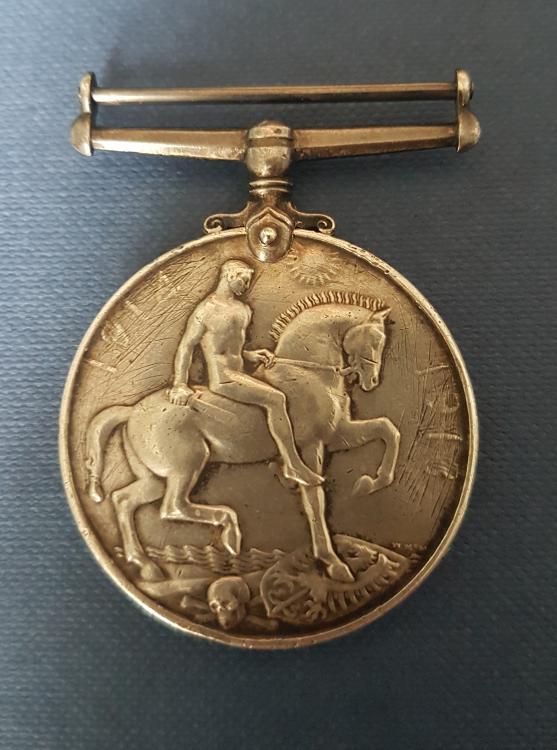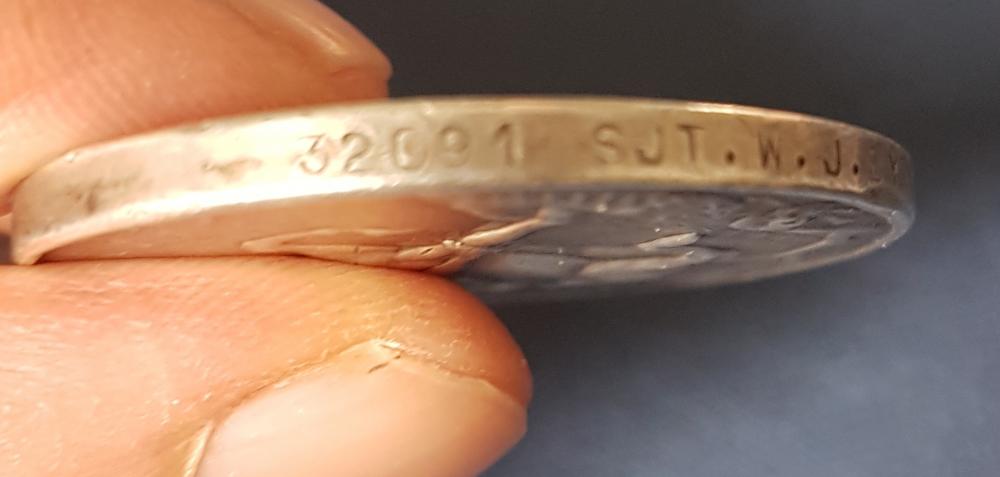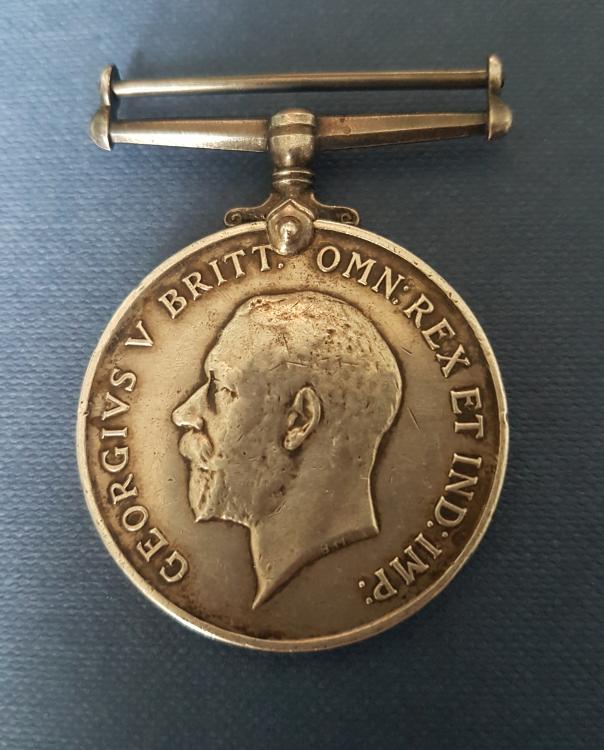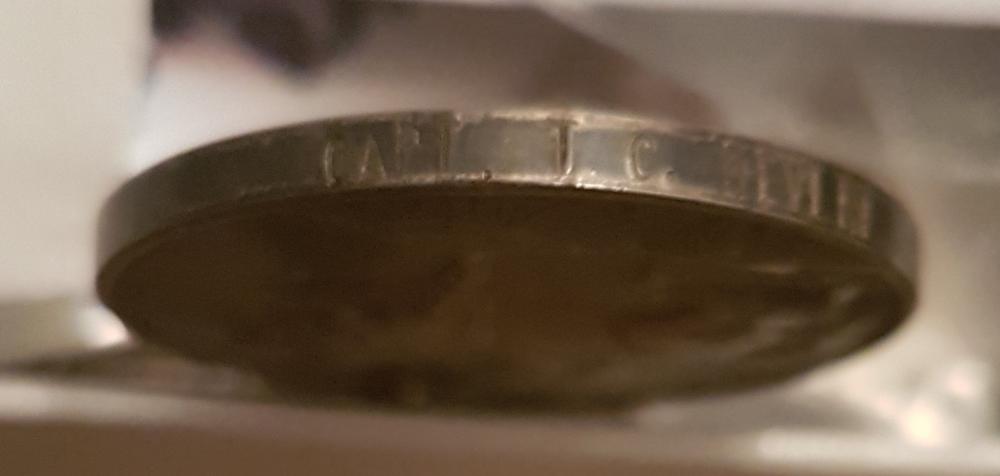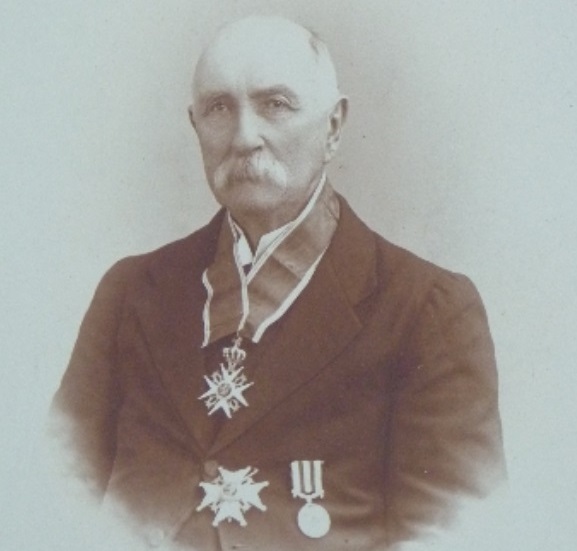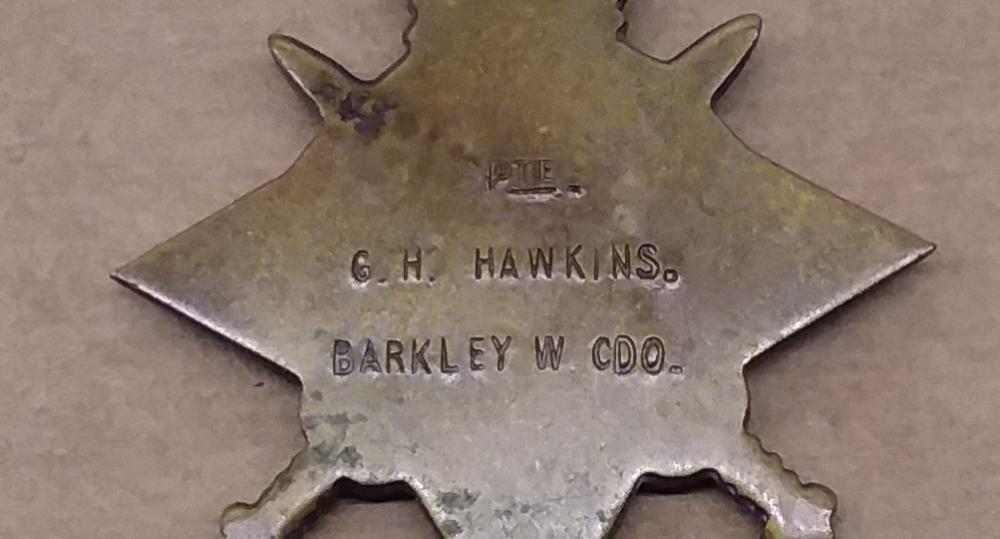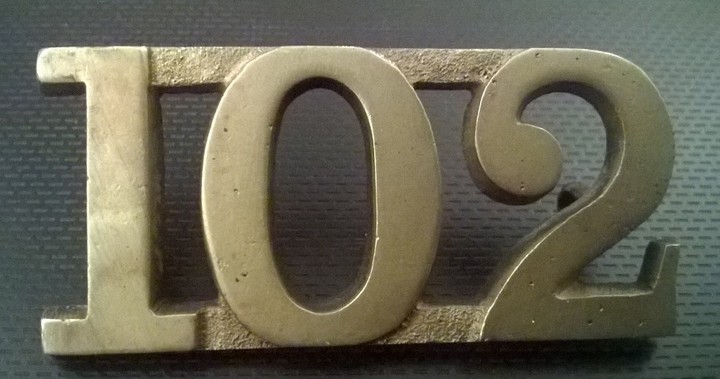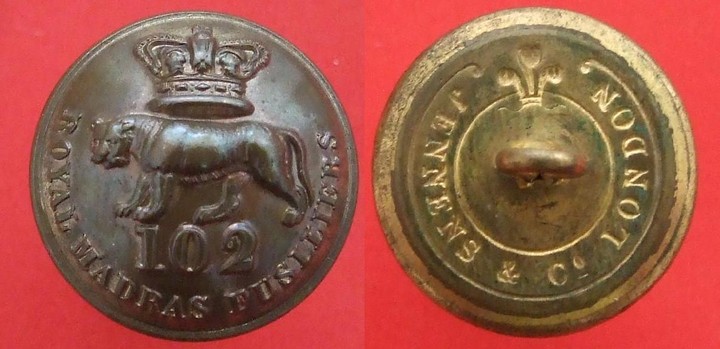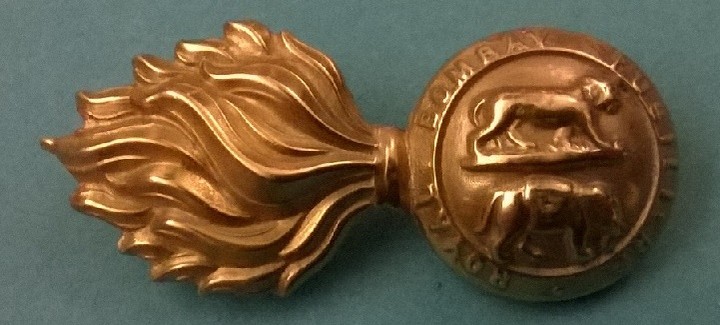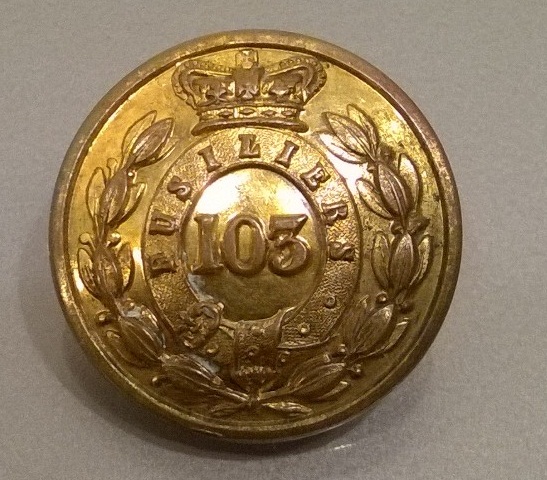-
Posts
3,925 -
Joined
-
Last visited
-
Days Won
5
Content Type
Profiles
Forums
Blogs
Gallery
Events
Store
Everything posted by Noor
-
Thank you so much guys! Now, I actually bought the medal from the medals dealer in UK so surely this one has been around!
-

Single BWM to Royal Artillery
Noor replied to Noor's topic in Great Britain: Orders, Gallantry, Campaign Medals
-
Hi all, Here is one of my last pick-ups - a single British War Medal to a 32091 Sergeant William Joseph Byrne, Royal Artillery. But checking him out turned this medal something very special... William lost his mother in young age. 1901 census shows him living with his widower father and older sister in Cork, Ireland. Originally from Kings County (County Offaly now). He must been born around 1887. 1911 census don't show him so he must be serving by then. He entered into France in August 1914 as a sergeant. 1 January 1916 he was Mentioned in Despatched.... 16 May 1916 he received DCM for bravery on the field A year later he received another DCM (A bar on the first DCM)!!! There were only 492 double DCMs for British forces in the Great War. So, a rare entitlement ndeed! William was promoted to the rank Battery Sergeant Major. Sadly he died in service 7th April 1920 in India. He is burried in Rawalpindi War Cemetery. Sadly I wasn' able to find out cause of his death. Also local Irish newspapers do not mention that brave soldier at all. Pictures of his medal
-
-
Thank you so much guys! Mystery remains - from where was Captain T C Devlin from?
-
Thanks Peter! That looks like is prefect match for Normal Coll CC!!! So, because no trace of him on this side of water then I think he may be from Canada!
-
Anybody?
-
Hi all, I obtained a British War Medal that is named to Captain T.C.DEVLIN . Unfortunately I am not able to locate him on the Medal Index Cards patch or in the medal rolls. I have a feeling that he may be from South Africa or Canada forces. I am not sure how Australia and New Zealand named their officer's medals. However, with help from The Great War Forum members, they found out that there was one Captain T.C.Devlin in the British Army Lists, October 1912 - page 1362. Also Ancestry confirms that and shows his unit "Normal Coll CC". No idea what it is - Cadet College or something? Does any forum member here would be able to help me on the track in respect of this officer? Also I am missing fold3 access at the moment. If some of you who have an access would be so kind to download this page below and post it to here then that would be a great help. Thanking you in advance, Noor https://www.fold3.com/search/#query=Devlin&dr_year=m,1912-1920&offset=36&w=h3fd0oVxF
-
Hi all, Over the trade I picked up some random medals including two South African WW1 awards (BWM and VM) named to PTE.G.H.HAWKINS KALAHARI HRS. Sad part is that I can see his trio was on sale some years ago on eBay with the 1915 Star. Now its only a pair (at least star must be out there somewhere). I am just wondering how rare unit it is and is there any information where they were and what they did during the WW1. Not my cup of tea so most likely I will move them on some moment soon. Just wanted to use them as a learning pieces first. Thanking you in advance, Timo
-
Hi all, I just bought another medal for my humble collection and I desperately would like to find a copy of owners photo. Also any extra information about him and his service would be greatly appreciated. Especially any extra information from the Afghanistan campaign. So far I have information below: James Agnew McNeale (27th December 1843 – 13th August 1901) Lieutenant Colonel Commandant of 8th Bengal Cavalry James Agnew McNeale was born in Belfast in 1843, the son of John McNeale of Parkmount, Rush Park, Co. Antrim. In young age James studied in the Berkeley Villa School in Cheltenham, England. The school gave him a very good testimonial of his characteristics. Also he studied a period of time in W.Fraderick 2 Rue de Calais du Roule, Paris, France. He received a nomination for the Royal Indian Military College (Addiscombe Military Seminary) on 28th May 1860. It cost about £300 to put a young gentleman through the course. As usual with 19th century educational institutions, the pupils led a tough existence, which might have helped them to cope with the hard career path they had chosen in India. They also learned Indian languages which were essential if they were to successfully command native infantry, cavalry and engineer units. The college closed in 1861 so he must been one of the last ones who studied in there. After one year of study he was appointed as an Ensign in the Bengal Infantry on 8th June 1861. In following year he was promoted to the rank of Lieutenant 30th July 1862. Following promotion took place after 8 years when he received a rank of Captain on the 9th May 1870, also he became a Third Squadron Commander, 8th Regiment, Bengal Cavalry (Formerly 18th Irregular Cavalry). James must been regularly visiting home because he played cricket for Ireland in a crushing defeat by the MCC in 1871 at College Park, Dublin. On the 13th February 1873 James got married with Amelia Lucy Luard in Meerut. She was a daughter of Colonel Peter William Luard, 55th Native infantry. Luard served with the Army of the Sutlej in 1846. Commanded the 17th Punjab Infantry after the Mutiny of the 55th Native Infantry, with the Saugor Field Brigade under Brigadier Wheeler in 1859. A year later, 7th January 1874 their daughter Emily Ida McNeale was born at Meerut, India. She lived in India all of her young age, until moved back to England with her mother in 1906. Following year newspaper “The Homeward Mail” lists that on 11 May 1875 a son John Hugh McNeale was born to them as well at Peshawur, North-West Province. United Kingdom 1881 Census shows that he was visiting Cheltenham with Mother and sister. Father, James Agnew McNeale, remains in India. He studied in Clifton Collage 1889-90. John joined with India Police Department 21st October 1895 and was posted as Assistant District Superintendent., Central Provost and promoted to District Superintendent June 1903. He retired September 1924. John moved back to England and he dies in Cheltenham 1956. When the Second Anglo – Afghan war started then Captain McNeale was sent to there. 8th Bengal Cavalry was attached under Kandahar Field Force, 1st Division, Cavalry Brigade under command of Brigadier General Walter Frane. Kandahar Field Force had one of the most difficult and daunting task to clear and pass the valleys up to the city of Kandahar. When the Peshawar and Kurram Field Forces were able support each other and indeed eventually met up then the Kandahar Field Force was virtually cut off from the rest of the campaign and had to support itself autonomously for the entire course of the campaign. This column did not face the same kind of large scale resistance as the other two columns did, but suffered from a potentially far more paralysing problem for the force; supply. The Kandahar Field Force animals were dying in their hundreds and thousands in the difficult terrain and with the worsening weather conditions. Added to this, was the fact that the local tribes were quite happy to prey on any group of carts that did not look sufficiently well defended. Despite all the problems, on the 8th January 1879 Kandahar Field Force enters into the city. James got promoted again on 8th June 1881 when he became a Major. He was still holding a position as a Squadron Commander, 8th Bengal Cavalry. Finally he was promoted to Lieutenant Colonel and he held a position of Commandant in the 8th Bengal Cavalry on 8th June 1887. At that time service in India was uneventful. June 1894 8th Bengal Cavalry paraded under command of Colonel McNeale for Queen-Empress seventy-fifth birthday at Allahabad, a city in Uttar Pradesh state, north India. A salute of thirty-one guns and the feux-de-joie being fired, after which the flag was saluted and three cheers were given for her Majesty. Lieutenant Colonel McNeale retired in 1898 after 38 years of service with the colours. Sadly he wasn’t able to enjoy his well-earned retirement long because James McNeale died only aged 57, in India on 13th August 1901 and he is buried in Gulmarg. His headstone inscription reads "In loving memory of Col. James Agnew McNeale, Genl. List Infantry, Late of the 8th Bengal Lancers, who died at Gulmarg August 13th, 1901. Aged 57 years." Widow, Amelia and daughter Emily, proceed to England on February 1906. She lived with their daughter in Gloucester and passed away 1929.
-
Hi all, I rarely find time to post here something so I decided to do it now. Please find one nice China War medal below that I picked up yesterday. Finished initial research today and I am delighted about the amount of information was available of him: James Henry Gordon Casserly (25th July 1869 – 7th April 1947) Lieutenant Colonel 120th Rajputana Infantry / 20th Regiment, Bombay Infantry Honorary Commander of the United Arts Rifles James was born 25th August 1869 as a son of James Henry Casserly and Maria Rourke. At that time they lived in 1 Chatham Street, Dublin. This property was owned by Casserly family at least from 1853. Up to 1887 there was a pub called “Casserly Travern”. The pub called “Neary’s pub” can be traced back to 1887 when Thomas Neary was the proprietor and the name has stayed with the bar ever since. Even today there are some old belongings from that period in this old pub in Dublin city centre. Young age James studied in the Trinity College. He passed his final exams on 1889 based on the Daily Express, 15th November 1889 list. Then he was commissioned as a Second Lieutenant into the 4th Battalion, Royal Dublin Fusiliers. He was promoted on the 23rd April 1890 to the rank Lieutenant serving in the 4th Battalion, Royal Dublin Fusiliers 23 April 1890. 4th Battalion, Royal Dublin Fusiliers was a City of Dublin Militia unit and from that, on the 10th October 1891 he was commissioned into the Northamptonshire Regiment as a Second Lieutenant for regular service. Shortly after that transfer he travelled to India with the unit. Two years later he was transferred to the Indian Army on the 5th June 1893 as a Lieutenant. Lieutenant Casserly was appointed to the 20th Regiment of Bombay Infantry on the 27th February 1897. During that time he was two years a Commandant of outpost near Himalayas called Buxa Duar which guards the pass into India from Bhutan. Based on his experience there he wrote later on one of his well-known books “Life in an Indian Outpost”. He describes the daily incidents of social and political life in an isolated station, varied by sporting expeditions and visits to Darjeeling. Forest Lodge the Second, which was built after a destructive elephant had ruined the first house in the trees. From “Life in an Indian Outpost” by Major Gordon Casserly Few years later he became a double company commander with 20th Regiment of Bombay Infantry on the 4th August 1900. He was attached to the 22nd Regiment of Bombay Infantry 2nd July 1900 and is noted as being employed as a Company Officer but also in charge of the depot of the Hong Kong Regiment according to the January 1901 Indian Army List. The 22nd Regiment served on the China 1900 campaign – it was their first battle honour. Within the China Expeditionary Force the 22nd Bombay (Native ) Infantry was listed as comprising 13 British Officers,17 Native Officers and Hospital Assistants, 721 NCOs and men, 59 Public followers, 35 Private followers, with 13 officers chargers and 8 ponies. In their attached transport detail they had 108 pack mules with 2 Jemadars and 4 Daffudars and 36 Drivers. The bulk of the Regiment were at Hong Kong as Garrison Troops but on the 9th June 1900 the HQ Wing embarked at Calcutta on the m.v.Patiala arriving on the 24th July 1900. It would appear that they did not deploy to North China and remained in Hong Kong as Garrison troops. After tour in China during the Boxer Rebellion he was promoted to the rank of Captain on the 10th July 1901. In 1903 the regiment name had changed to 120th Rajputana Infantry. After six years of service he was promoted once again to the rank of Major on the 10th October 1909. In the January & April 1915 Indian Army List he is noted as being on leave, outside of India on a medical certificate from 28 November 1913 and this had been extended 6 months. The 120th Rajputana Infantry went to Mesopotamia in November 1914 as part of the original expeditionary force and ultimately forced to surrender at the fall of Kut in April 1916. However it does not look like he was with them. Instead Belfast News from 13th April 1914 shows that at that time he published one of his first books; “Mr. Werner Laurie is just publishing “Life in an Indian Outpost” by Major Casserly. This is a thrilling account of the life of an Indian officer in command of a native garrison in a small post on the frontier. The outpost is called Buxa Duar, and is on the face of the Himalayas, guarding one of the Gates of India. The book gives a wonderfully vivid idea of the peculiarity and loneliness and risks of such a life. Major Casserly tells his story in a manly, straightforward, and direct way, and the book will appeal to all lovers of sport and daring.” In the July 1915 Army List is noted as being on leave, outside of India on a medical certificate 1 year 8 months. Probably due to his age and ill-health he was transferred to the Half-Pay List on the 28th November 1915 (LG 4 Feb 1916) In the January 1916 Army List is still noted as being on leave, outside of India on a medical certificate. On 10th January 1916 he received a Special Appointment, graded as a Staff Captain (LG 27th January 1916) but in the same year he retired as a Major due to ill-health on 11th October 1916 (LG 1 Dec 1916). In the Indian Army List he was classed as Major retired but liable to be recalled to active service until 1919 (Jan 1919 IAL). Major Casserly was promoted to the rank Lieutenant Colonel on 14th November 1919 on the retired list in accordance with, the provisions of A.C.I. 644 .and 1213 of 1918 the London Gazette 17th February 1920. In the same date he became a Battalion Commander of 14th County of London Volunteers Regiment. Also he became a Honorary Commander of the United Arts Rifles. In the Great War Major Casserly didn’t take actively part of the war overseas, therefore 1900 China Campaign medal is his sole entitlement. Colonel Gordon Casserly, how people know him, was a life member of the Société de Géographie d'Alger. Also he was a British Consul St.Moritz 1916-1917. He published following books: Novels “The Elephant God” “The Jungle Girl” (1922) “The Red Marshal” (1920) “The Desert Lovers” “The Sands of Death” “The Monkey God” (1929) “Tiger Girl” “Love’s Lottery” (1938) Short stories “Daughter of Eve” Travel “The Land of the Boxers” “Algeria To-day” (1928) “Tripolitania” (1925) “Life in an Indian Outpost” (1914) Nature “Dwellers in the Jungle” (1925) “In the Green Jungle” (1927) Play “Bubbies and the Don” One-act plays “The Idol” “The Test” “Lady Hamilton” “The Fatal Empress” “The Lunatic” Military “Jungle and River Warfare” (1914) “Training of the Volunteers for War” “Tactics for Beginners” “Company Training” “Trench Warfare”
-

Unidentified foreign order
Noor replied to Noor's topic in Great Britain: Orders, Gallantry, Campaign Medals
Thank you do much! -
Hi all, Can anybody help me to identify this chap neck order and breast star please. Medal on his chest must be Indian Mutiny medal. I am thinking something from Vatican/order of St.John knights of Malta or even Brunswick House Order of Henry the Lion? Any ideas would be great help, Noor
-
Hi all, I have here another random medal that I would like to research a little before I move it on. Unfortunately somehow medals to an officers that I have got have all some African connection :). Now, I have here a Victory medal to Lieutenant Donald J Waters. His medal index card shows that he was in General List, Highland Light Infantry and then with 3rd Battalion Nigerian Regiment. London Gazette shows that he was attached to West African Frontier Force from 1st October 1915. He landed in Africa 3rd October 1915 (MIC - zone 4C). He relinquish commission from West African Frontier Force and was granted rank Captain on 25th June 1919. I wasn't able to find anything else about him. Any help would be greatly appreciated! Thanks, Timo
-
Hi Brett, Thank you so much for your help! As I said, I picked this medal up only because to challenge and learn research possibilities regarding SA officer and after that I most likely let it go then. Therefore I do not start seeking a researcher who can dig more out for me from the archive. But because his interesting name, I was able already get some info of him from the main online research sites. Once again, thank you for your help and inputs - it has been a good guide for me. Talk you soon, Timo
-
Thanks Brett! I got one copied page with the medal - confirms his rank, first name, unit, 1915 Star entitlement and also when he served in SW Africa. Also using internet, I was able to confirm this info: First served in Matabele Wars (1893-1897) with the B. B. Police, Mafeking (medal roll). His regimental number was 1384 and he was entitled the campaign medal with the Shangani and Singuesi clasps. Then as a Sergeant-Major in Cape Police. He received QSA with the clasps “Defence of Kimberley” and “Orange Free State”. He was commissioned 4th January 1901. Worked in Cape Mounted Police (1910). Married with Rosa Beatrice Watermeyer (nee du Preez). Resided Barkly West. Daughter Wilhelmina Emily was born 04.07.1909 and son James Frederick 1913. Served as a Captain in the 5th South Africa Mounted Rifles, Cape Mounted Police (CMP) based in Kimberley. He saw active service in South West Africa from 23rd August 1914 until 9th July 1915.
-
I push this old post up - I randomly picked up a British War Medal that was named to "T/CAPT F.E. WATERMEYER" . Turns out that Frederick Edward (Frederick Egidius Benedictus) Watermeyer worked for Cape Mounted Police (1910). He was married with Rosa Beatrica (nee du Preez) and they had at least two children. During the war Frederick served with the 5th Regiment South Africa Mounted Rifles in SW Africa 23.08.1914 - 09.07.1915. He was entitled at least 15 Star trio. No other awards are known to me at the moment. Can some of you advise where else I should look for information of him and his service? Thanks, Timo
-

My humble collection - second start
Noor replied to Noor's topic in Great Britain: Orders, Gallantry, Campaign Medals
My yesterdays pick-up. I am very pleased with this QSA (still researching his personal life): W. Brown (1873 – xxxx) 4352, Private, 1st Battalion (mounted infantry) Royal Dublin Fusiliers William Born was born in St.Mary’s parish in Cork around 1873. William joined the Royal Dublin Fusiliers at Naas depot 9th February 1892. At that time he was 19 years old. Medical examination showed that he was 5 feet and 9 inches tall and weigh 133 pounds. On the 8th April same year he was posted to 1st Battalion. Private Brown had some problems at that time – on the 23 November 1893 he was awaiting a trial and he was convicted for thief on 18th January 1894. Hi service continued after 120 days punishment on the 18th May 1894. He served in Ireland until 1st May 1896. After that he was sent to South Africa where he staid following year till 1897. However, he must been a good soldier because 18th May 1896 he received a Good Conduct Badge. He must be part of 1st Battalion Mounted Infantry unit because when Ndebele people rose up against the rule of the British South Africa Company during Second Matableland War (also known as the Matableland Rebellion) and the group comprised of 31 men under the command of Captain Alexander john Godley (later a general and commander of the New Zealand Expeditionary Force) and Captain Arthur Forde Pilson where put together and sent as a part of British troops to Rhodesia. War broke out on 17 June 1896 at Mazowe with an attack by the Hwata dynasty on Alice Mine. This was followed by the medium Nehanda Nyakasikana capturing and executing Mazowe Native Commissioner Pollard. With the war in Matabeleland ending, Gen. Carrington was able to concentrate his forces on Mashonaland and the rebels retreated into granite kopjes. With no central command to oppose him, Carrington was able to bring Maxim guns against each stronghold in turn, until resistance ended. Just 33 of British South Africa Company medals were awarded to members of the column from Royal Dublin Fusiliers in recognition of their services in operations during the Second Matableland. One of them was as well Private Brown. William Brown was elected to come under new regulations on messing allowances under the provisions of Royal Warrant dated 31 March 1898. He received 2nd Good Conduct Badge on 18th May 1898.On the 9th February 1899 he was sent to Army Reserve. His civil life didn’t last long because he was mobilized again under special army order of 7th October 1899. On the 10th November 1899 he was once again on the way back to South Africa. He stayed in South Africa during whole Boer war until 2nd February 1902. After that he was still with the colours extra 2 years and was demobilised on the 8th February 1904, after 12 years of service. During his time in the war he took part of operations and battles in Laing’s Nek between 2 and 9 June 1900, operations during the Relief of Ladysmith between 15 December 1899 and 28 February 1900. Based on his papers William’s father lived 195 Blarney Street, Cork. Awards: - British South Africa Company Medal (Rhodes 1896 type). - Queen South Africa Medal - King South Africa Medal -

My humble collection - second start
Noor replied to Noor's topic in Great Britain: Orders, Gallantry, Campaign Medals
Patrick Babester (16.01.1886 – 23.06.1972) 8958, Private, 2nd Battalion Royal Dublin Fusiliers Patrick was born in Dublin on the 16th January 1886 as a son of Richard Joseph Babester and Mary Jane Babester (née Lenehan). At that time they lived 66 Church Street (tragedy took place there at the 2nd September 1913 when two houses, including number 66 collapsed and killed many residents). His family living conditions were poor because Patrick’s name appears on the Dublin Workhouses Admission & Discharge Registers from very young age. Workhouses in Ireland were established under the Act for the Effectual Relief of the Destitute Poor in Ireland, which was passed in 1838. The North and South Dublin Workhouses provided more than just refuge for the absolute destitute of the city. When he got older, he was sent to Saint Anne's Ward Belfast. Based on 1901 Census he is listed there as a 15 years old pupil. After his time in Belfast, Patrick joined 2nd Battalion, Royal Dublin Fusiliers for regular 7 years of service and 5 years of Army Reserve. On the 1907 he became a father of Pauline Annie Babester (Babister) (1907-1979). 1908 Patrick lived on 7 Magers Court (Charlotte Street) in Dublin. He got married with Rose Hutchinson on the 09 January 1908. Sadly this marriage didn’t last long – Rose Babester died same year when she was only age 21. Few years after discharge, 1911 Irish Census shows that Patrick was unemployed general labourer and at that time he stayed with his sister Mary Dolan’s home in 36 Newmarket, Merchants Quay. Following year 1912 electoral roll shows that Patrick still lived in the same address in his sister’s house. When the Great War started, Patrick was mobilized from reserve and he was one of the first Royal Dublin Fusiliers soldiers who were sent overseas with his unit – 'The Old Toughs' 2nd Battalion, Royal Dublin Fusiliers. Private Babester landed in Boulogne at 23rd August 1914. His unit saw action almost immediately in Belgium and lost large amount of officers and men killed, wounded or more “lucky ones” found themselves as Prisoners of War (POW). All of this happened due to the hectic retreat from Mons and Le Cateau area in Belgium where Dublin Fusiliers objective was to provide a rear guard force that would cover the retreating British Expeditionary Forces. Among of the soldiers who were captured by Germans was as well Private Patrick Babester who became POW on the 28th August. Over the Christmas period, his Christmas box was sent to his new home address in Dublin - 21 Chambers Street. Also his name was published on the Irish Times Prisoner of War list at 23rd April 1915. Those who were captured were mainly put into a prisoner of war camp at Limburg. It was the camp that Roger Casement went in to try and recruit an Irish brigade. Casement misjudged these Irishmen’s loyalty to each other. They had come through hell and were not going to betray their fellow soldiers with whom they had fought and died. A dispatch from the German War Office in March 1915 gave details of a rule for all Prisoner of War Camps. Prisoners were not allowed to write more than two letters a month, not exceeding four pages, and six pages of ordinary size in the case of officers and soldiers respectively. In addition, one postcard a week was allowed. The causes of death among POWs vary from camp to camp and vary throughout the war. Flu caused quite a few deaths as did fleck or spotted typhus, especially in Wittenberg. TB became a problem at Limburg and it will have caused significant casualties though many would be after the war. In tented camps in 1914-15 there were a significant number of deaths caused by the poor conditions which were far worse than those described in Limburg. A small number died through accidents and some were shot. Many also died as a result of lack of care and medical attention. It proved difficult for the Germans to provide a prisoner of war with everything they needed for a reasonable existence. As the war progressed the Royal Dublin Fusiliers Prisoners of War Committee became more and more important who organised special supplies to POWs. When the Great War ended and Patrick was released from captivity and he turned back to civil life. He served all together 10 years and 6 months. Out of that time4 years and 3 months he was POW. After active service he went to work in Guinness brewery at 26th May 1919. At that time he was 33 years of age. He worked there as an Electrician's Helper (Employee ID 15881). Guinness’s brewery was active in looking after employees who joined the colours. Even every enlisted worker received half pay while serving. Company re-employed all the returning servicemen and also widows (37) were treated generously. Nevertheless the company not only took back former employees but recruited another 694 ex-servicemen, 259 of them on a temporary basis and some suffering from disabilities. The Engineers’ Department was one of the largest departments in the St.James’s Gate Brewery. The Engineers’ Department was responsible for all building construction and maintenance as well as mechanical and electrical engineering projects in the Brewery. The Engineer’s Department supervised the construction of all Brewery buildings and brewing machinery. By the 1960s, there were over 1100 people employed in the Engineers’ Department, including skilled craftsmen such as boilermakers, patternmakers, carpenters, painters, scaffolders, bricklayers, plumbers, blacksmiths and coppersmiths as well as professionals such as architects and engineers. Patrick most likely married again with Ellen Babester (died in Ireland 1957). They lived 120 Lismore Road, Terenue/Kimmage. Patrick retired from the Guinness on the 16th January 1951. Most likely after his wife passed away Patrick immigrated to UK and settled in Salford, Lancashire. At the moment I am not able to confirm it yet but most likely he had two children – Francis (Frank) Patrick Babester (1933 – 2005) and Anthony Francis Babester (1931-1994). His address there was probably 16 Rigby Street, Salford, Lancashire. Patrick Babester died on the 23rd June 1972 in Salford, Lancashire. one set of medals that find way back into my collection - I am very pleased because I really enjoyed doing that research! Henry Murray “Chippi” Letchworth, M.A. (6th February 1889 - December 1964) Captain, Commander of “Y” Company 1st Battalion, Royal Dublin Fusiliers Henry Murray Letchworth was born in 6th February 1889 at Exton which is small village in Hampshire, England, he had a twin brother Arthur Gordon Letchworth and older brother George Howard Letchworth. His twin brother Arthur served with the Royal Munster Fusiliers and after the war worked as a clerk with the Health Ministry (he died in 1933). In his early years Henry lived with his aunt at Newlyn, Adelaide Road, Kingston, Surbiton where he was recorded in the 1891 and 1901 census. In his teenage years Henry entered the Haileybury and Imperial Service College, which is known as a prestigious British independent school, near Hertford (32 km from central London). 1907 he matriculated to the Oriel College, Oxford, where he studied Theology, Henry was also member of the Officer Training Corps which he left in October 1910. In 22nd July 1911 he got a 3rd class Honors Degree, 4 years later, on the 3rd April 1915 he achieved a Master’s Degree. At the same Henry started working as an Assistant Master on the Beechmont Preparatory School, Sevenoaks and he lived at 3 Ethelbert Road, Canterbury, Kent. When the Great War broke out, Henry responded to the King’s call and put his application forward on the 22nd March 1915 to become an officer in the British Army, his candidature was accepted and he was appointed a commission in the Special Reserve of Officers with the 4th Royal Dublin Fusiliers in the rank of 2nd Lieutenant. On the 20th of December 1915 the London Gazette supplement confirmed that 2nd Lieutenant Henry M. Letchworth has attested to the Royal Dublin Fusiliers. During his time in Ireland, he was stationed with the 4th battalion Royal Dublin Fusiliers in Templemore Barracks. Ironically Henry got his first combat experience here, when the 4th Battalion was sent to Dublin during the Easter Rising 24–30 April 1916 where they also suffered casualties, a detachment of 4th Battalion is also reported as being in Dublin Castle. In July 1916, 2nd Lieutenant Letchworth was attached to the 8th Battalion Royal Dublin Fusiliers, at this time this unit fought on the Western Front as a part of 48th Brigade of the 16th (Irish) Division. Their hardest challenge took place on the fields of France and Belgium – the 1916 Somme offensive. Henry was sent back to England on the 7th of September 1916 from Le Havre on the HMMS Panama and he arrived back to Southampton on the 14th September 1916. Due to his health condition, the medical board of the 2nd Southern General Hospital in Bristol granted him a leave from 18th September to 17th October. Henry joined the 4th Battalion Royal Dublin Fusiliers again on the 26th October 1916, at this time they were based in Mullingar. The following year on the 1st of July 1917 Henry was promoted to the rank of Lieutenant (25.10.1917 London Gazette). At this time, he was attached to the 1st Battalion Royal Dublin Fusiliers, which arrived back from their service in the Balkans the previous year. Most likely this move took place during the reorganisations in October 1917, when the battalion was transferred to the 48th Brigade 16th (Irish) Division or earlier. Unfortunately it is impossible to trace that transfer. Henry must have proved himself as a valuable front line officer as from the 15th of February 1918 Henry was appointed to the rank of Acting Captain (19.04.1918 London Gazette), but things took a very different turn on the 21st March 1918. The previous year the German High Command had decided to make a decisive attack in the west in the following spring and their target was the British Army in the Somme area. The Germans plan was to destroy British units before American forces could build up their strength. The New offensive was called the "Kaiserschlacht" (Kaiser's Battle) or known now as the “Spring Offensive”. The Germans planned to use their new tactics, which they practised on the Russian front – intense artillery barrage against key points such as machine-gun posts, headquarters, railways, telephone lines, etc. Attacks would be carried out by small well trained groups - stormtroopers, whose main aim was to move forward through gaps in the front and try to surround the main frontline troops. The attack started with the artillery bombardment at 4.40 am on 21 March. The bombardment targeted an area of 150 square miles, the biggest barrage of the entire war. Over 1,100,000 shells were fired in five hours. In the end, over 320 soldiers from Royal Dublin Fusiliers were killed in this battle and many of them were taken prisoners. I have the privilege to have a copy of Acting Captain Henry Murray Letchworth’s own report of what happened on that day. He was 1st Battalion, Y Company commander at this time. He wrote the following statement on the 16th of January 1919: I was in command of Y Company, which had 2 platoons in the front line and 2 in support at C.H.Q. At 4.30 am 21.3.18 the enemy started a very heavy barrage of gas and H.E. which continued until 10.30 am. Platoon commanders got fair cover for their platoons, but we lost around ¼ of our strength during the bombardment. At 7 am I visited the platoons, the fog was then very thick and continued so all the morning. All communications with B.H.Q. except by runners, was broken. Enemy first attacked about 10.30 am and got into the front line, but we drove them out again with the aid of one of the reserve platoons by 11.30. Informed B.H.Q. 11.40 and got a reply to hold on. Had conference with O.C. X a Z coys about noon. At 12.30 pm saw the enemy in trenches on our sight, and at 1 pm they were firing from LEMPIRE. Suffered very heavy casualties from their machine gun fire. A second attack started at 2 pm., in which remains of coy were driven back around C.H.Q. all platoon commanders were casualties. Only 30 men were left. Sent off last a message to B.H.Q. at 2.30 pm, after that time the enemy were in our rear, and our own guns were firing on us. The Enemy’s third attack took place about 3.45 pm. I was captured with Capt.J.Kee (X Coy, which was on my left) who was very badly wounded in the thigh, at about 4.15 pm. Captain Letchworth became one of the 4 officers and 290 men missing after the attacks. He was captured near Epehy and Lempire. The Book “Bluecaps” also indicates what he said in his last message which he sent off at 2.30pm to the Battalion Headquarters: Reports from the wounded made it clear that the men in the front line were very hard pressed, but at the same moment a very noble message came from Acting Capt Letchworth, commanding Y Coy that "he was surrounded but would hold on to the end”. Regarding the moment when he was captured, I was able to find out who was the wounded Captain, sadly this man never made it back to Ireland: William Kee, Acting Captain, MC, from Meenagrove, Co.Donegal. Officially he served in the 7th Battalion but after commission in 1915 rose the ranks to be Acting Captain and was attached to the 1st Battalion. He was brave man indeed, Mentioned in Despatches twice and Military Cross ( bar posthumously 16th September 1918) for his valour in Somme, he died three days later in Germans hands on the 24th March 1918. Captain Letchworth had the fortune (good or bad is a matter of opinion in those “days of death”) to be taken prisoner of war by the German forces and he was first sent to Karlsruhe officers prison camp (Karlsruhe¬Offiziere Camp) in Baden. Officers were held in camps reserved only for them. There were living conditions less harsh then the regular soldier’s camps. They had beds, separate rooms for their meals and they were able to be involved in study or sport. After his capture, his next of kin address to the Germans was recorded as; Reverend Canon. H.H. Letchworth, 3 Ethelberth Road, Canterbury. Also during his time as a POW, he became a life-long friend with the Lieutenant John Herbert Brereton Sewell from 5th Manchester Regiment, who introduced few years later to him new passion of his life – Scouting. In late 1918 the war finally ended. One clause of the 11th November 1918 Armistice dealt with the matter of prisoner-of-war repatriation: “The immediate repatriation without reciprocity, according to detailed conditions which shall be fixed.” Overall, these prisoners were speedily repatriated. Henry was released from the prison camp on the 19th of November 1918 and he arrived back to England on the 29th of November 1918. At this time he gave his own address as 62 Old Dover Road, Canterbury, Kent. He relinquished his rank Acting Captain on the 19th of March 1919 and left army service with the 4th Battalion Royal Dublin Fusiliers on the 23rd of August 1920. After the war Henry returned back to teaching and he became Co-Principal at Chafyn Grove School, Salisbury from 1920 onwards. During these years, he coached the school rugby team and produced the annual school play. In school his nickname was Slush (what he did not like). Four years after he was liberated from the Prisoner of War camp, he met his friend again with whom he was a POW with – John H.B. Sewell was invited to join the staff of Chafyn Grove School. Henry himself, had never been a Scout, but he and his twin brother had in their youth frequently been on camping holidays together. Sewell, who was already District Commissioner for Stockport, quickly enthused him with the ideals and challenge of the movement. John H.B. Sewell remained at the school until 1931 from then onwards Letchworth was in full time charge of the 16th Salisbury (Chafyn Grove School) Scout Group. At the annual Scout Camp, he was known as Chippi - this name he didn’t mind and which probably dated back to the war. When the Second World War broke out he was commissioned as a 2nd Lieutenant on the 25th of November 1942 (Extract from London Gazette 11.06.1943). On 25th of May 1944 he was promoted to the rank of Lieutenant (Extract from War Office Orders 21.09.1944). He served with the Army Cadet Force, (personal number P275884/1) and rose to the rank of Major when he was appointed as an Officer to the 7th Cadet Battalion, Wiltshire A.C.7. Henry resigned on 30th April 1945 from that position and on the 29th of May he relinquished his commission. His main passion all of his life had been teaching and Scouting, after he joined the Scouts Organisation in 1923, he remained active with them for forty years. His great capability in Training Scouters was soon recognised and in 1928 he became Assistant County Commissioner (Training), and was subsequently active in arranging courses for Scouters. In addition he took on the job of D.C. South Wilts in 1938, remaining there for ten years. He carried much of the burden of maintaining Scouting in the County as well as District during the 1939-1945. On returning from his County position in 1954 he became a Deputy Camp Chief attached to Gilwell Park, a rare distinction. Papers indicate that he lived at this time at 12 Bourne Avenue, Salisbury. It is an old Victorian house and nowadays it is a nursing home. Further details about him show that he did a bit travelling after the war with the Scouting. In the summer of 1955 he went to New York on SS Queen Elizabeth and arrived back in September from Canada on SS Saxonia. He visited the 8th World Scouts Jamboree at Niagra-on-Lake, Canada during 18-28 August. Henry Murray Letchworth died on December 1964 after a short illness. He was 75 years of age. His death is registered England & Wales, Death Index 1916-2005 role as October-December 1964, Salisbury district, Wiltshire (Volume 7c, page 531). For his service during First World War as a Royal Dublin Fusiliers officer, Captain Henry Murray Letchworth was award the Victory Medal and British War Medal (he applied for his medals on the 3rd of April 1921), however in regards his World War Two medal entitlement at this point it is impossible to confirm if he did receive any awards (Defence Medal and/or War Medal) For his devotion and hard work for Scouting Organisation, “Chippi” received during the Second World War the highest award presented by The Scout Association “for services of the most exceptional character” – The Silver Wolf Award. This award in 1922 was an award for Adult volunteers for Services to Scouting and awarded only by the Chief Scout of the World. -
I bring this old post up to live again. Currently the best bet is that it is very early Dublin Glider Club . Thanks, Timo
-

Officer's busby badge - my last find!
Noor replied to Noor's topic in Great Britain: Militaria: Badges, Uniforms & Equipment
Here are few pieces that I have from pre 1881 period: Here is my only militia item so far (Irish militia items are usually hard to find and expensive) - a single 4th Battalion (City of Dublin Militia) collar. post 1881 officer's collars:


